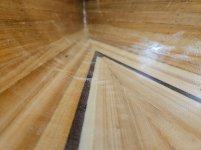After a summer of building raised beds, desks and floating shelves, I'm finally getting back to my canoe.
I just finished sandng the outer hull and I can see the cloth in a number of places. Most are at the edge of a double layer (football/stem) which I'm less concerned about, but there are a few places on the side as well. Would it be worthwhile rolling on another layer of epoxy to cover?
I just finished sandng the outer hull and I can see the cloth in a number of places. Most are at the edge of a double layer (football/stem) which I'm less concerned about, but there are a few places on the side as well. Would it be worthwhile rolling on another layer of epoxy to cover?



